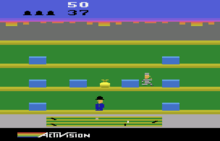Keystone Kapers
| Keystone Kapers | |
|---|---|
 | |
| Developer(s) | Activision |
| Publisher(s) | Activision |
| Designer(s) | Garry Kitchen |
| Platform(s) | Atari 2600, Atari 5200, Atari 8-bit, ColecoVision, MSX, Xbox 360, Windows |
| Release date(s) | 1983 |
| Genre(s) | Platform |
| Mode(s) | Single player |
Keystone Kapers is a video game published by Activision for the Atari 2600 in April 1983, and later ported to the Atari 5200, Atari 8-bit family, ColecoVision, and MSX in 1984. Inspired by Mack Sennett's slapstick Keystone Cops series of silent films, the object of the game is for Officer Keystone Kelly (the player) to catch Harry Hooligan before he can escape from a department store.
Gameplay

The game takes place on a side-view display of a three story department store and its roof. The store is eight times wider than the portion in the main display, and the screen scrolls to the left or right when the player reaches the edges. Movement between the levels is accomplished by escalators located at alternating ends of the map, or an elevator in the center. A mini-map at the bottom of the screen provides and overall view of the store and the location of the players.
The player controls Officer Keystone Kelly with the joystick, which is used to run to the right or the left along a given floor. When he reaches an escalator he will be taken up to the next floor. Kelly can also use the elevator in the center of the map to move up and down, but doing so requires careful timing as it moves on its own. Kelly begins the game in the lower right on the first floor, and normally begins running to the left to reach the escalator to the second floor.
Harry Hooligan starts the game in the center of the second floor. He immediately begins running to the right in an attempt to reach the elevator to the third floor. Hooligan continues moving up the floors in an attempt to reach the roof via the escalator on the left side of the third floor. If he succeeds he escapes. This trip takes 50 seconds, and a timer at the top of the screen counts down the remaining time. Kelly runs significantly faster than Hooligan and can normally catch him in that time in a straight run with no penalties.
Kelly can also use the elevator to between levels. If he moves ahead of Hooligan, Hooligan will reverse direction and start back down through the store. He is aided in this by the ability to jump down between levels at either end of the map, something Kelly cannot do. This means Kelly has to use the elevators carefully, or risk being stuck on a higher floor while the timer runs out.
Slowing Kelly's progress are a number of still or moving obstacles like radios, beach balls, shopping carts and others, which he can jump over or duck under by pushing up or down on the joystick. Touching any of these objects causes a nine second penalty. In later levels there are flying toy biplanes that will cause the player to lose a life upon contact.
The game begins with the player given three lives. One is lost every round that Hooligan remains uncaught when the timer runs out. The game proceeds through rounds until the player runs out of lives. Extra lives are awarded at every 10,000 points, up to the maximum of three.
If Kelly catches Harry, the player will score points based on the amount of time they have left. On levels 1-9, the player will score what is left on the clock multiplied by 100 points; on levels 10-15, the amount left on the clock is multiplied by 200 points, and afterwards the amount left on the clock is multiplied by 300 points. Kelly can also pick up suitcases and bags of money for 50 points each.
As with most early video games, there is no end to the game; each level gets progressively harder, adding more and/or faster hazards until Kelly loses all of his lives.
Ports
On May 12, 2010, the Atari 2600 version of Keystone Kapers was released on Microsoft's Game Room service for the Xbox 360 and Windows-based PCs.
Reception
The Atari 2600 version of Keystone Kapers received a Certificate of Merit in the category of "1984 Videogame of the Year (Less than 16K ROM)" at the 5th annual Arkie Awards.[1]:40
The Atari 8-bit version was praised in Antic, who called it a "perfect game for anyone" and praised its "superb animation".[2]
Deseret News gave the ColecoVision version of Keystone Kapers 3 stars. It praised the game's graphical improvement over the original, unusual for an Activision port.[3]
References
- ↑ Kunkel, Bill; Katz, Arnie (January 1984). "Arcade Alley: The Arcade Awards, Part 1". Video. Reese Communications. 7 (10): 40–42. ISSN 0147-8907.
- ↑ "Keystone Kapers". Antic. December 1984.
- ↑ Holyoak, Craig (1984-05-30). "Here are ColecoVision's jewels". Deseret News. pp. 4 WV. Retrieved 10 January 2015.
External links
- AtariAge entry for Keystone Kapers
- Keystone Kapers TV commercial
- The Atari 2600 version of Keystone Kapers can be played for free in the browser at the Internet Archive